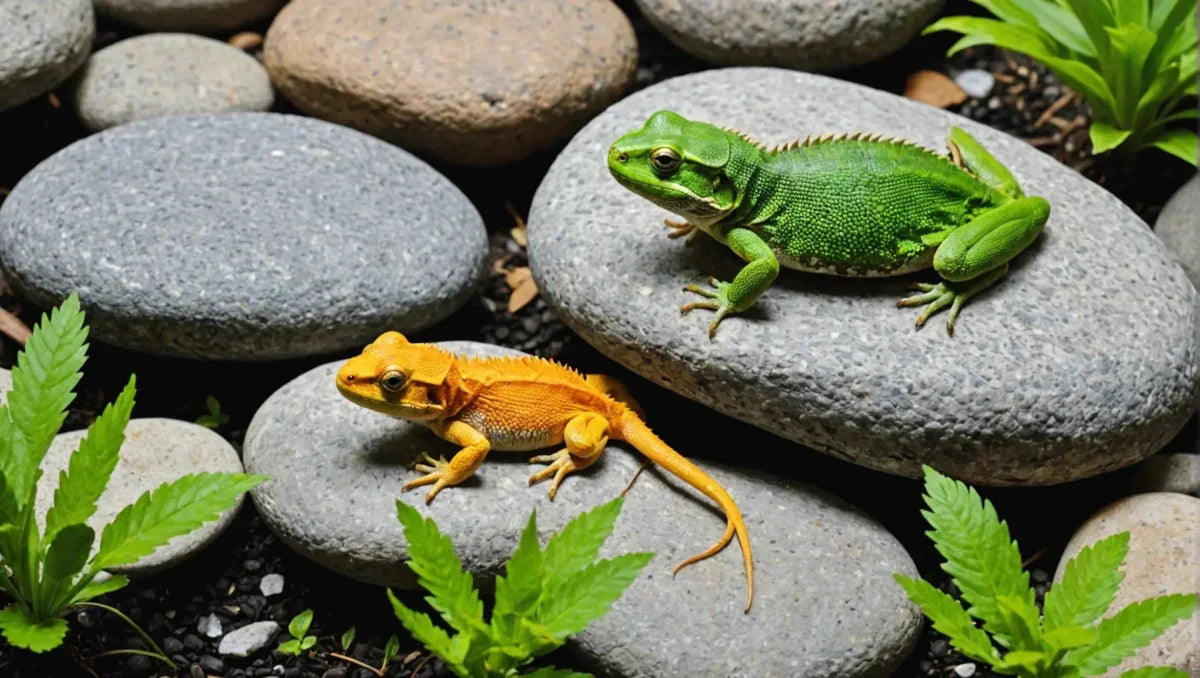Creating a Suitable Habitat for Your Reptile

Creating a suitable habitat for your reptile is essential for its well-being. Rocks can be a fantastic addition to your reptile's enclosure, providing not only aesthetic value but also functional benefits. Offering natural climbing surfaces, basking spots, and hiding places, rocks mimic the reptile's natural environment. They assist in regulating temperature and humidity levels, fostering a healthier living space for your pet. Moreover, rocks aid in wearing down your reptile's nails and encouraging natural behaviors like climbing and exploring. When choosing rocks for your reptile's habitat, prioritize safe, non-toxic options that are easy to clean and do not harbor bacteria. By integrating rocks into your reptile's habitat, you can establish a more enriching and stimulating environment that closely resembles its natural habitat, ultimately enhancing your reptile's overall quality of life.
Types of Rocks Suitable for Reptiles
Creating a suitable habitat for reptiles involves careful consideration of various elements, including the type of rocks used in their enclosure. Rocks not only serve as decorative features but also play a crucial role in promoting the well-being of reptiles. In this comprehensive guide, we will delve into the different types of rocks that are safe and beneficial for reptiles, exploring their unique characteristics and advantages.
Sandstone: A Popular Choice
- Sandstone is a favored option for reptile enclosures due to its natural appearance and texture, mimicking the reptiles' natural habitat.
- Its rough surface aids reptiles in shedding their skin effectively, promoting healthy skin maintenance.
- Sandstone's ability to retain heat makes it an ideal material for creating warm basking spots, essential for reptiles' thermoregulation.
Slate: Durable and Hygienic
- Slate stands out for its durability and non-porous nature, making it easy to clean and maintain in reptile habitats.
- This rock type does not harbor bacteria, ensuring a hygienic environment for reptiles to thrive.
- With its cool surface, slate provides reptiles with a comfortable area to regulate their body temperature.
Granite: Sturdy and Visually Appealing
- Granite is a robust rock that can withstand the activities of reptiles, offering long-lasting durability in their enclosure.
- Available in various colors and patterns, granite adds aesthetic appeal to the habitat, creating an engaging environment for reptiles.
- Its effective heat retention properties provide reptiles with cozy resting spots, promoting relaxation and comfort.
Lava Rock: Lightweight and Versatile
- Lava rock's lightweight and porous nature make it an excellent choice for creating hiding spots and climbing surfaces for reptiles.
- It aids in maintaining optimal humidity levels within the enclosure, crucial for the health of reptiles.
- Safe for reptiles to bask on, lava rock also enhances the natural look of the habitat, enriching their living space.
Quartz: Safe and Aesthetically Pleasing
- Quartz, available in various forms like crystal clusters or sand, is a versatile and non-toxic rock suitable for reptiles.
- Its safe interaction with reptiles makes it an ideal choice for enriching their habitat.
- Adding a touch of sparkle, quartz contributes to creating a visually appealing environment for reptiles to thrive.
Selecting the right rocks for your reptile's habitat is crucial for their overall health and well-being. Each type of rock discussed offers distinct benefits that cater to different aspects of reptile care. By understanding the unique characteristics of these rocks, you can create a safe, engaging, and enriching environment for your reptilian companions.
Section: How to Incorporate Rocks in Your Reptile's Enclosure
Enhancing Your Reptile's Habitat with Rocks
Rocks can play a crucial role in creating a natural and stimulating environment for your reptile. By incorporating rocks thoughtfully into your reptile's enclosure, you can provide not only aesthetic value but also functional benefits that mimic their natural habitat. Here's a comprehensive guide on how to safely and creatively add rocks to your reptile's habitat:.
- Choosing the Perfect Rocks:
-
Opt for reptile-safe rocks such as slate, quartz, or granite. These rocks are non-toxic and provide a safe surface for your pet to interact with. Avoid rocks like limestone or sandstone, which can alter the pH of the enclosure.
-
Preparing the Rocks:.
-
Before introducing the rocks to the enclosure, clean them thoroughly with a reptile-safe disinfectant. You can also sterilize the rocks by boiling them or baking them in the oven to eliminate any harmful bacteria.
-
Designing the Layout:.
-
Consider the needs of your reptile species when arranging the rocks. Create a variety of surfaces for basking, climbing, and hiding. Incorporate different sizes and shapes of rocks to add texture and visual interest.
-
Ensuring Safety and Stability:.
-
Securely position the rocks to prevent any accidental collapses. Test the stability of each rock and ensure they are firmly in place to avoid injuries to your reptile. Smooth out any sharp edges that could pose a risk.
-
Monitoring and Maintenance:.
-
Regularly inspect the rocks for any signs of wear, mold, or debris buildup. Clean the rocks periodically with warm water and a mild detergent to maintain a hygienic environment for your reptile.
-
Enhancing Enrichment:.
- Use rocks to create a dynamic environment that encourages natural behaviors. Add tunnels, caves, and elevated platforms to stimulate exploration and physical activity.
Incorporating rocks into your reptile's enclosure is not only beneficial for their well-being but also adds a touch of nature to their living space. By following these guidelines and getting creative with rock placement, you can transform your reptile's habitat into a captivating and enriching sanctuary.
Additional Tips for Rock Arrangement:
- Creating Microclimates:
-
Place rocks strategically to create different temperature zones within the enclosure. This allows your reptile to regulate its body temperature effectively by moving between warmer and cooler areas.
-
Natural Hiding Spots:.
-
Use rocks to design natural hiding spots for your reptile. These secluded areas provide a sense of security and privacy, reducing stress levels and promoting natural behaviors.
-
Mimicking Natural Landscapes:.
-
Research your reptile species' natural habitat to replicate the landscape with rocks. Incorporate plants, branches, and other elements to create a realistic and engaging environment that closely resembles their wild surroundings.
-
Interactive Feeding Stations:.
- Integrate rocks into feeding stations to encourage foraging behavior. Hide food items under or between rocks to stimulate hunting instincts and mental stimulation during meal times.
By incorporating these additional tips into your rock arrangement, you can further enhance your reptile's enclosure and provide a diverse and enriching habitat that promotes their physical and mental well-being.
Section: Maintenance and Cleaning Tips
Keeping your reptile's habitat clean is crucial for their health and well-being. Here are some maintenance and cleaning tips to ensure a healthy environment for your scaly friend:.
- Regular Spot Cleaning:
-
Remove any feces, shed skin, or uneaten food daily to prevent bacteria buildup.
-
Deep Cleaning Schedule:.
-
Establish a routine for a deep clean of the entire habitat. This includes removing all substrate, cleaning the enclosure with a reptile-safe disinfectant, and replacing substrate.
-
Cleaning Rocks and Decor:.
-
Rocks and decor in the habitat can harbor bacteria and parasites. Regularly scrub and rinse these items with hot water to keep them clean.
-
Importance of Clean Water:.
-
Ensure that your reptile always has access to clean, fresh water. Change the water daily and clean the water dish regularly.
-
Monitoring Humidity and Temperature:.
-
Proper humidity and temperature levels are essential for your reptile's health. Regularly check and adjust these levels as needed.
-
Avoiding Harsh Chemicals:.
-
When cleaning the habitat, avoid using harsh chemicals or cleaners that can be toxic to reptiles. Stick to reptile-safe cleaning products.
-
Proper Ventilation:.
-
Adequate ventilation is crucial to prevent the buildup of harmful gases like ammonia. Ensure there are proper vents in the enclosure.
-
Quarantine New Rocks and Decor:.
-
Before adding new rocks or decor to the habitat, quarantine them to prevent introducing pests or diseases to your reptile's environment.
-
Inspecting for Wear and Tear:.
-
Regularly inspect rocks and decor for any signs of wear or damage. Replace any items that could potentially harm your reptile.
-
Enrichment Activities:.
-
Incorporate cleaning and maintenance activities into your reptile's enrichment routine to stimulate their mind and keep them active.
-
Seek Veterinary Advice:.
- If you notice any unusual behavior or health issues in your reptile, consult a reptile veterinarian for guidance on maintaining a clean and healthy habitat.
Maintaining a clean and hygienic habitat for your reptile is not just about aesthetics; it directly impacts their health and well-being. Regular cleaning and maintenance routines are essential to prevent the buildup of harmful bacteria and ensure a safe environment for your scaly companion.
When it comes to cleaning rocks in your reptile's habitat, it's important to pay special attention to these natural elements. Rocks not only provide climbing surfaces and hiding spots for your reptile but can also trap debris and bacteria if not properly maintained. Here are some additional tips specifically for cleaning rocks in your reptile's enclosure:.
- Gentle Scrubbing Techniques:
-
Use a soft-bristled brush or sponge to gently scrub rocks with warm water. Avoid using harsh chemicals or abrasive materials that can damage the rocks or leave behind harmful residues.
-
Boiling Method:.
-
For rocks that can withstand heat, consider boiling them in water for a few minutes to sterilize and remove any impurities. Allow the rocks to cool completely before returning them to the habitat.
-
Sunlight Exposure:.
-
Natural sunlight can help disinfect rocks naturally. If possible, place rocks in direct sunlight for a few hours to kill bacteria and parasites.
-
Rotating Rocks:.
-
Regularly rotate the rocks in the habitat to expose all surfaces to light and airflow. This helps prevent moisture buildup and promotes a healthier environment.
-
Monitoring Rock Condition:.
- Keep an eye on the condition of the rocks. Discard any that show signs of deterioration, such as crumbling or discoloration, as these can pose a risk to your reptile.
By incorporating these rock-specific cleaning tips into your overall maintenance routine, you can ensure that your reptile's habitat remains clean, safe, and conducive to their natural behaviors. Remember, a clean habitat is a happy habitat for your scaly friend!.
Safety Precautions and Considerations
When it comes to creating a habitat for your reptile, safety should always be a top priority. Here are some essential safety precautions and considerations to keep in mind:.
-
Choosing the Right Rocks: Select rocks that are smooth and free of sharp edges to prevent injuries to your reptile.
-
Avoid Toxic Rocks: Some rocks may contain minerals or elements that can be harmful to reptiles. Research and ensure the rocks you choose are safe for your pet.
-
Secure Rocks: Make sure that any rocks placed in the enclosure are securely positioned to prevent them from falling and potentially harming your reptile.
-
Cleaning Rocks: Regularly clean and sanitize the rocks in the enclosure to prevent the growth of harmful bacteria or mold.
-
Monitoring Temperature: Rocks can absorb and retain heat, which can affect the temperature in the enclosure. Monitor the temperature to prevent overheating or chilling.
Mitigating Risks:
-
Supervise Interaction: When introducing rocks into the enclosure, closely monitor your reptile to ensure they are not ingesting or getting stuck in between the rocks.
-
Provide Hiding Places: Create hiding spots using rocks to offer your reptile a safe space to retreat and reduce stress.
-
Vet Consultation: Before making any significant changes to the enclosure, consult with a reptile veterinarian to ensure the safety and well-being of your pet.
Additional Safety Measures:
-
Size and Weight Consideration: Choose rocks that are appropriate in size and weight for your reptile species to prevent accidents or injuries.
-
Avoid Pesticides: Ensure that the rocks are free from any pesticides or chemicals that could be toxic to your reptile.
-
Natural Habitat Simulation: Arrange rocks in a way that mimics the natural habitat of your reptile, providing enrichment and mental stimulation.
-
Regular Health Checks: Inspect your reptile regularly for any signs of injury or discomfort that may be caused by interactions with rocks.
-
Emergency Preparedness: Have a plan in place in case of emergencies involving rocks, such as accidental ingestion or entrapment.
By following these comprehensive safety precautions and considerations, you can create a secure and enriching environment for your reptile to thrive in.
Conclusion
Incorporating rocks into your reptile's habitat can provide numerous benefits, such as creating natural basking spots, aiding in shedding, and adding visual interest to the enclosure. By carefully selecting and arranging rocks, you can enhance your reptile's overall well-being and create a more stimulating environment that mimics their natural habitat. Remember to prioritize safety by choosing rocks that are non-toxic, smooth-edged, and securely positioned to prevent any potential harm to your reptile. With proper consideration and maintenance, rocks can be a valuable addition to your reptile's habitat.





